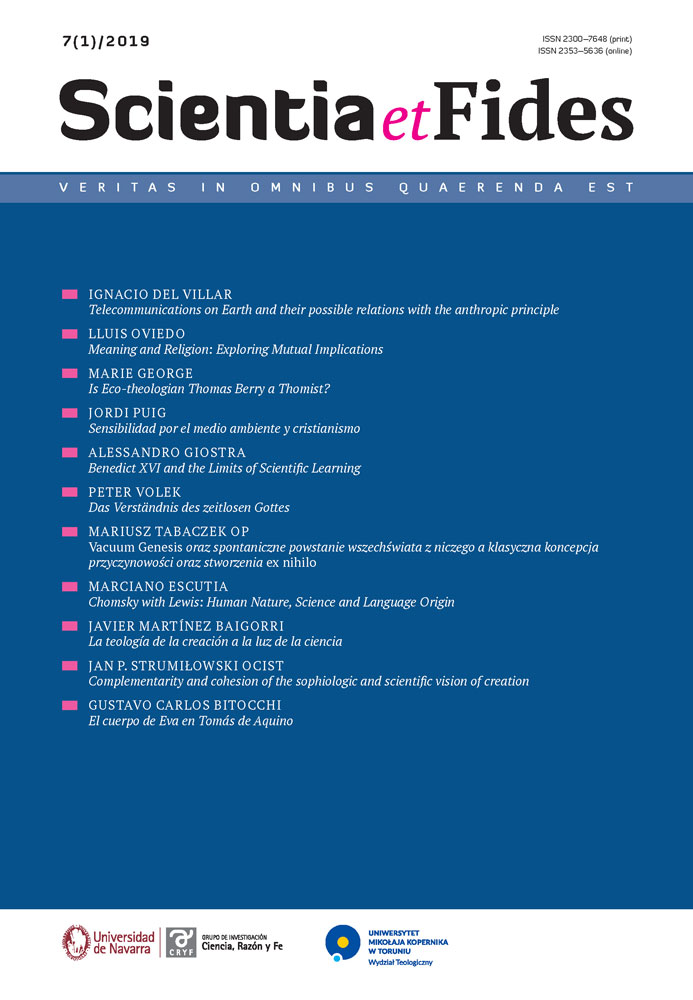El cuerpo de Eva en Tomás de Aquino
Słowa kluczowe
body, matter, man, Adam, woman, feminismAbstrakt
The body of Eva in Thomas Aquinas
The constitution of the first female body or the body of Eva presents several physical and metaphysical problems, problems that have gone through the centuries and reach the present, generating social and cultural consequences for women. The non-existence of parents demands from Aquino answers that go beyond the anthropological and biological and lead to the search of philosophical answers intertwined with the theological ones. Thomas Aquinas provides rational answers although the background is of faith, and even, with literal interpretations of the Sacred Scriptures now abandoned. The Aquinate makes an intellectual effort to find answers in a rational field because the matter of the body of the first woman brings difficulties for its elucidation and understanding. As in other parts of his extensive work, Thomas Aquinas, follows the biological and physical works of Aristotle. Although the Aristotelian background is in line with Christian thought, Aquinas shows his extraordinary capacity for synthesis between the faith received and reason argued, between revelation (and especially the Holy Scriptures in this case) and the principles of reason.
Bibliografia
Alby, Juan. 2007. “La medicina medieval y la filosofía tomista del cuerpo”. XXXII Congreso Internacional de la Sociedad Tomista Argentina: Filosofía del cuerpo: Artículo 22.
Archideo, Lila Blanca. 1991. “Bases para una antropología femenina en Santo Tomás”. Atti del IX Congresso Tomistico Internazionale: 91–104.
Archideo, Lila Blanca. 2004. “Un aporte al humanismo cristiano: la mujer y la amistad. Sus bases en Santo Tomás de Aquino”. Atti del Congresso Internazionale su l'umanesimo cristiano nel III milennio: la prospettiva di Tommaso d'Aquino: vol. 1, 287–293.
Argüello, Santiago. 2005. Posibilidad y principio de plenitud en Tomás de Aquino. Pamplona: Eunsa.
Balmaseda Cinquina, María Fernanda. 1995. “El neofeminismo y la concepción de la mujer según Santo Tomás”. Philosophica: 18, 181–201.
Gilson, Etienne. 1951. El tomismo. Introducción a la filosofía de Santo Tomás de Aquino. Buenos Aires: Desclée, de Brouwer.
Hartel, Joseph Francis. 1993. “Femina ut imago Dei, In the Integral Feminism of St. Thomas Aquinas”, Analecta Gregoriana 269, 83–89.
Horvat, Sasa. 2017. “Neuroscientific findings in the light of Aquinas'
understanding of the human being”, Scientia et Fides 2 (2017), 127–153.
Oliboni, Melissa. 1995. Anima e corpo in Tommaso d'Aquino: una rilettura. Recanati: Editore Leopardi.
Popik, Kristine Mary. 1979. The Philosophy of Woman of St. Thomas Aquinas. Rome: Ed. Pontifical University of St. Thomas Aquinas.
Rossi, Teodora. 1991. “Il corpo muliebre nell’articolo 1 della q. 92, I pars”. Studi Tomisti, 42, 105–110.
Tomás de Aquino. 1988. Suma de Teología. Madrid: Biblioteca de Autores Cristianos, 5 Tomos http://hjg.com.ar/sumat/ (31.03.13).
Tomás de Aquino. 2005. Comentario a las Sentencias de Pedro Lombardo, Libro II, La formación de la mujer, Volumen II/1 La creación: Ángeles, seres corpóreos, hombre. Pamplona: Eunsa.
Tomás de Aquino. Corpus Thomisticum. http://www.corpusthomisticum.org/ (31.03.13)
Pobrania
Opublikowane
Jak cytować
Numer
Dział
Licencja
CC BY ND 4.0. Posiadaczem prawa autorskiego (Licencjodawcą) jest Autor, który na mocy umowy licencyjnej udziela nieodpłatnie prawa do eksploatacji dzieła na polach wskazanych w umowie.
- Licencjodawca udziela Licencjobiorcy licencji niewyłącznej na korzystanie z Utworu/przedmiotu prawa pokrewnego w następujących polach eksploatacji: a) utrwalanie Utworu/przedmiotu prawa pokrewnego; b) reprodukowanie (zwielokrotnienie) Utworu/przedmiotu prawa pokrewnego drukiem i techniką cyfrową (e-book, audiobook); c) wprowadzania do obrotu egzemplarzy zwielokrotnionego Utworu/przedmiotu prawa pokrewnego; d) wprowadzenie Utworu/przedmiotu prawa pokrewnego do pamięci komputera; e) rozpowszechnianie utworu w wersji elektronicznej w formule open access na licencji Creative Commons (CC BY-ND 3.0) poprzez platformę cyfrową Wydawnictwa Naukowego UMK oraz repozytorium UMK.
- Korzystanie przez Licencjobiorcę z utrwalonego Utworu ww. polach nie jest ograniczone czasowo ilościowo i terytorialnie.
- Licencjodawca udziela Licencjobiorcy licencji do Utworu/przedmiotu prawa pokrewnego nieodpłatnie na czas nieokreślony
PEŁEN TEKST UMOWY LICENCYJNEJ >>
Statystyki
Liczba wyświetleń i pobrań: 1160
Liczba cytowań: 1



